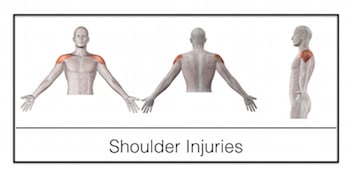Shoulder Personal Injuries
 Trauma or injury to the shoulder can be caused by an accident or incident that is caused by the negligence or carelessness of another person, business, or government entity. The severity and type of injuries can range from a minor bruise or sprain to a more significant injury that requires surgery due to a fracture or tear of one or more parts of the shoulder. Some fractures cannot be readily repaired so the arm / shoulder is immobilized and the patient undergoes a term of physical therapy to help with pain, function and range of motion. Pain management is also an option for those shoulder injuries that do not respond to conservative treatment and therapy.
Trauma or injury to the shoulder can be caused by an accident or incident that is caused by the negligence or carelessness of another person, business, or government entity. The severity and type of injuries can range from a minor bruise or sprain to a more significant injury that requires surgery due to a fracture or tear of one or more parts of the shoulder. Some fractures cannot be readily repaired so the arm / shoulder is immobilized and the patient undergoes a term of physical therapy to help with pain, function and range of motion. Pain management is also an option for those shoulder injuries that do not respond to conservative treatment and therapy.
- The shoulder is comprised of three bones including:
- Clavicle which is commonly referred to as the collar bone;
- Humerus which is commonly referred to as the arm bone; and
- Scapula which is commonly referred to as the shoulder bone.
A shoulder can be fractured as a result of an automobile accident or other trauma. The most common fracture of the shoulder involves the Clavicle. Scapula fractures and Proximal Humerus fractures are not as common but can result from trauma resulting from an accident or incident.
The clavicle, humerus, and scapula are joined together by the soft tissues or connective tissues which consist of the joint capsule, muscles, tendons and ligaments. There are three joints that make up the shoulder which include the following:
- Stenoclavicular Joint;
- Acromioclavicular Joint; and
- Glenohumeral Joint.
These bones are joined together by soft tissues (ligaments, tendons, muscles, and joint capsule) to form a platform for the arm to work.
The shoulder is made up of three joints:
- Glenohumeral joint
- Acromioclavicular joint
- Sternoclavicular joint
A commonly reported injury to the shoulder area of the body involves the Rotator Cuff, which is a joint capsule that supports the arm at the shoulder joint. It consist of four tendons that stabilize the shoulder and attach to muscles. When the Rotator Cuff is injured as a result of trauma from an accident or incident, the injury victim can experience pain, discomfort, weakness, and decreased range of motion in the shoulder. Many Rotator Cuff injuries involve tears that require surgical international from an orthopedic surgeon. During the course of treatment and diagnosis, it is common to have an X-Ray of the shoulder, MRI of the shoulder, and clinical examinations and assessments to pinpoint the injury and to formulate a treatment plan for this particular type of shoulder injury.
A Dislocated Shoulder occurs when the upper arm bone pops out of the shoulder socket which is part of the Shoulder Blade. In particular, the Humerus (arm bone) separates from the Scapula (shoulder bone) at the Glenohumeral Joint.
Another commonly reported shoulder injury caused by trauma is called a SLAP Tear Injury which is a personal injury to the Labrum of the shoulder. The Labrum is a ring of cartilage that surrounds the joint of the shoulder. The SLAP Tear Injury refers to Supervisor Labral Tear from Posterior to Anterior. The SLAP Tear is found near the attachment of the biceps anchor. A SLAP Tear Injury can cause significant pain and a catching type of sensation in the shoulder / arm with movement of the shoulder / arm. With a SLAP Tear Injury, there can and often is pain, difficulty with activities of daily living, and instability. Some SLAP Tear Injuries require surgery and some do not.
It is important for an injury victim to get timely treatment. Furthermore, it is helpful to have a specialist (orthopedic surgeon) involved with the medical care to supervise the direction of the care and to diagnose the personal injuries casually related to a an accident or incident. It should be noted that in this age of specialist only certain orthopedic surgeons treat upper extremity and shoulder personal injuries. Many insurance companies will question the cause of any injury stemming from the accident or incident as claimed by the injury victim. It is important that the treating physicians document the injuries and make it clear in the medical records and / or by reports and testimony that the personal injuries were casually related to the incident or accident which is the subject of the claim or case. Because of the complexities of medical care, proof, and other issues, it is important for an injury victim to have the advice, guidance, and legal representation from a Florida Personal Injury Attorney preferably from the beginning of the case through its conclusion.
 David Alan Wolf, Personal Injury Attorney Home
David Alan Wolf, Personal Injury Attorney Home



